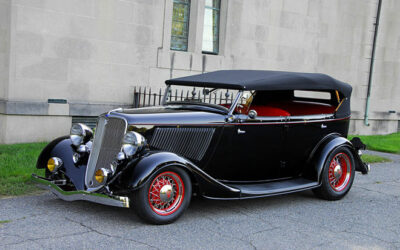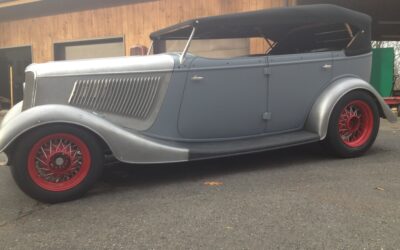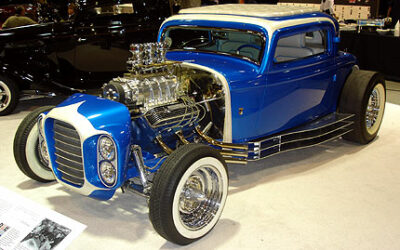No top, no paint, and this phantom two-door will remain that way
Feature Article from Hemmings Motor News
January, 2009 – Daniel Strohl
Dave Nixon is not an insecure man. Even before you meet him, this becomes evident via his chosen attire for the day: a vivid purple ball cap from an art car museum and a thick raccoon-fur coat.
But his assuredness extends beyond his fashion choices and into his 1936 Ford phaeton.
“I have no plans for a top,” he said. “If it rains, it rains.”
Easy enough for somebody from Arizona or New Mexico to say. Nixon, however, hails from Cape Cod, where even a summer night can prove to be rather chilly, and wet weather is not a seldom occurrence. But his plans for what not to do to the phaeton come not from boast and bluster, but from an appreciation of both the car and of the talent invested into its reconstruction. Nixon said he found the phae-ton in the mid- to late 1980s in a junkyard in Middleborough, Massachusetts. Its wood body structure had rotted away, which caused the unsupported body to collapse in on itself. Nixon thought it the perfect candidate for his vision of a hot rod, so he bought it out of the junkyard, and a couple of years later hauled it to legendary New England hot rod builder Dave Simard in Leominster, Massachusetts, a fellow member of the Boston Area Roadsters club.
Nixon’s first request: Lose two doors. Preferably the back ones. Which is a task easier said than done. While Ford built 5,555 four-door Deluxe Phaetons in 1936, the company built far fewer two-door phaetons. Far fewer, as in zero. So Simard had quite a bit of welding ahead of him. Fortunately, Nixon provided Simard with nine extra phaeton front and rear doors to cut up and splice in where appropriate. So Simard cut out four inches from the front of the rear doors, welded the rear doors shut, moved the door posts back four inches and then extended the front doors by four inches.
(Why not just lop the roof off a Tudor sedan? one might ask. Ford’s closed cars, of course, had different windshields and cowl transition areas than Ford’s open cars. To reshape a sedan’s cowl to match a phaeton’s cowl would have required far more work than to juggle around those four inches between the doors.) Nixon, knowing he’d permanently ditch the folding top, then had Simard fill in and reshape the top of the body’s backside, where Ford notched it to mount the folding top. So even if Nixon wanted to affix a top now, he couldn’t without cutting apart Simard’s work. Sans top (or any considerations thereof), Simard then chopped the windshield frame by two inches.
Simard then placed the body on a Total Cost Involved frame with independent front suspension. Nixon chose a carbureted Ford Motorsports 460-cu.in. crate engine backed by a Richmond five-speed manual transmission and Ford 9-inch rear axle for the drivetrain. Simard turned to Laconia, New Hampshire, based upholsterer Steve Pierce for a maroon leather interior stitched to fit the topless phaeton.
And then Nixon essentially told Simard to stop.
“I was originally going to paint it black, but when I saw it in bare metal like this, I told Dave to just leave it,” Nixon said. No filler, no primer, no paint, not even a clearcoat. Simard’s welds, though ground smooth, still show in some places. Only the stock chrome trim stands out from the bare metal of the body. To prevent the body from instantaneously flashing into rust while plying the roads of Massachusetts, Nixon now regularly rubs the entire body down with Gibbs penetrant.
Simard’s work and Nixon’s vision both paid off for the car when it earned a few full-page photo spreads in Ken Gross’s latest book, The Art of the Hot Rod, but for Nixon, the reward comes when he drives the phaeton all over southeastern New England.
Wearing that raccoon-fur coat when the thermometer starts to dip, of course.



